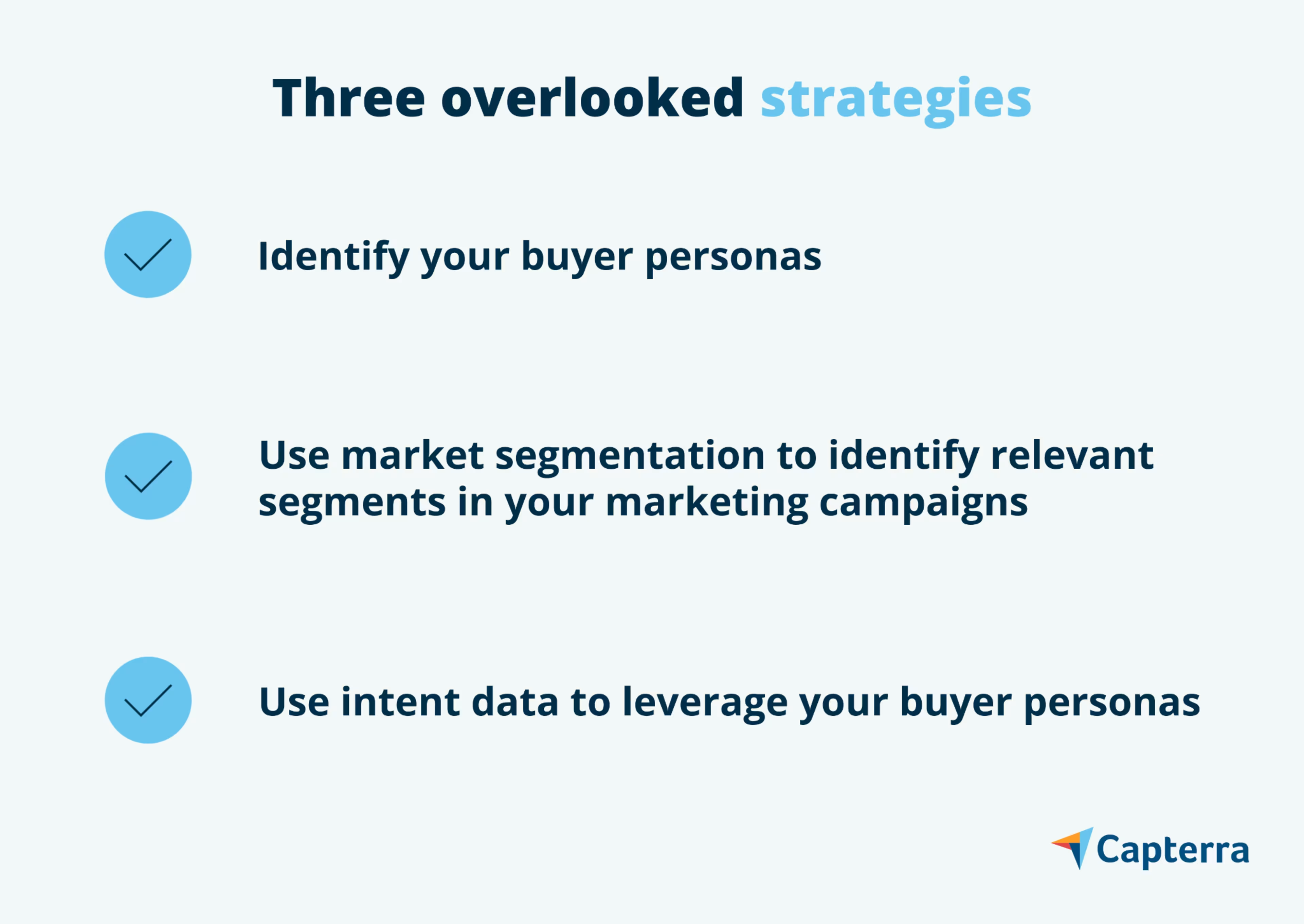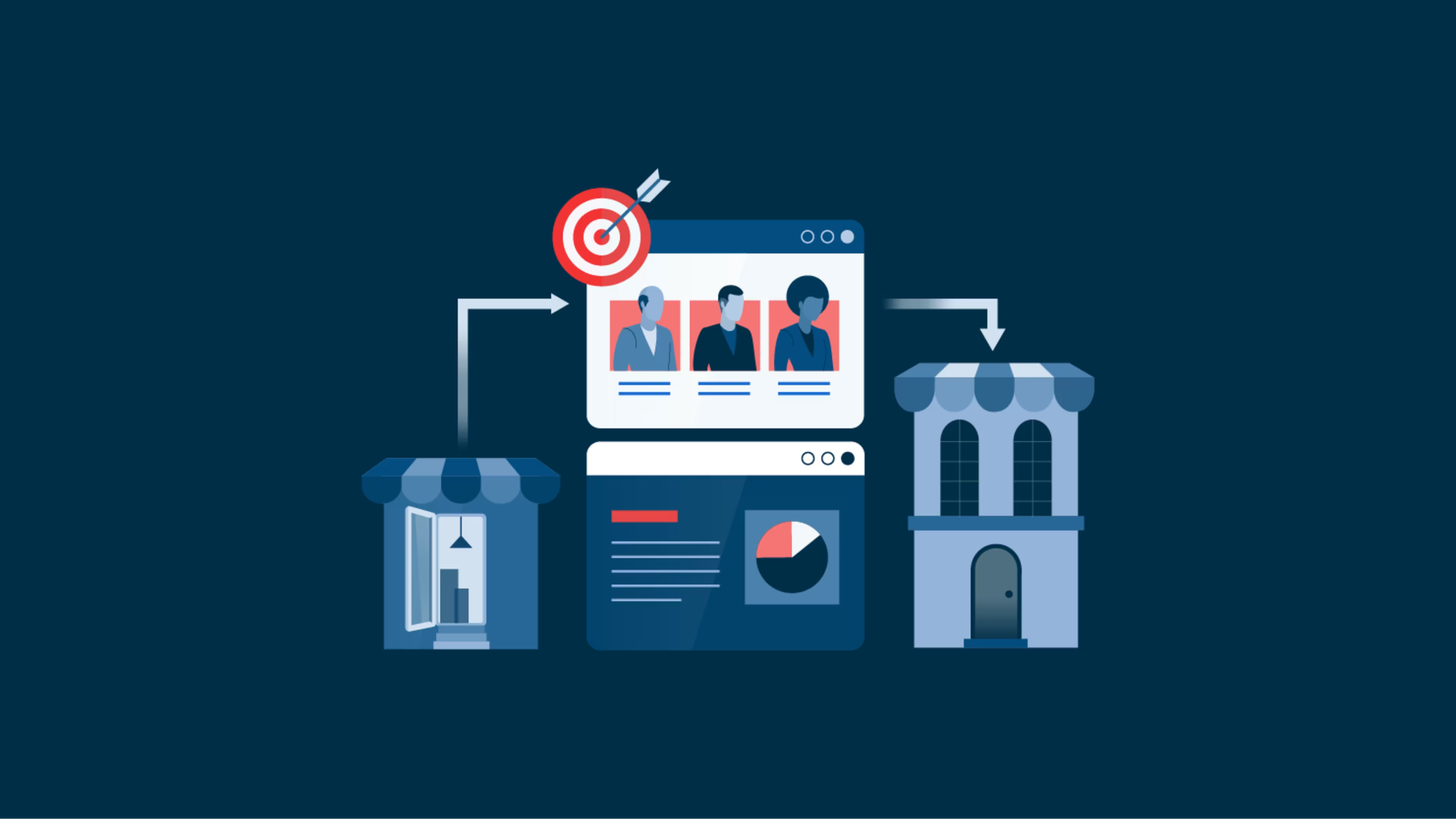Using persona targeting and intent data is the key to a successful B2B sales strategy. But how?
Business-to-business (B2B) organizations are often not achieving the sales they should be. Achieving this higher volume of sales requires intensive planning and the ability to target the correct buyers for your organization. Building detailed personas of buyers that are fluid and adaptive helps target buyers that are searching for a specific product or service and will easily help you boost your sales.
So how do you build these personas? There are three strategies that we’ll discuss today to help you build your specific buyer personas and then use them to increase your sales and bolster your sales strategy so your business is performing at its peak.

3 overlooked strategies to reshape your sales strategy
1. Identify buyer personas
The first step is to identify your personas. A persona is a type of customer model, a theoretical customer profile, and usually, it is your ideal customer. Your personas should incorporate all relevant data, including demographics, firmographics, past purchasing behaviors, and anything else you find that helps to fill out the picture of your ideal customer. Having a full buyer persona helps to drive your B2B sales by targeting customers searching for specific products.
Analyze your data
Using your data, which can come from a variety of sources including customer relationship management (CRM) software and your marketing automation platform (MAP), you can identify your most loyal customers and then use their profiles to develop your personas. However, this process of gathering information should not be limited to single individual profiles. Often, in B2B transactions, many individuals can form part of the sales conversion process. This is why it's important to analyze your client base by building personas from a variety of customer purchasing groups.
Once you have a baseline for your personas, make sure to integrate two primary pieces of data:
Individual job function, e.g., administrative, marketing, sales
Job title, such as president, purchasing manager, etc.
These two pieces of data are critical to making sure you build an accurate buyer persona.
Next, comes the behavioral data—how are your current customers behaving when they make purchases? Once integrated into a persona, this type of data can be measured against intent dataIdentifying personas and analyzing the relevant data is the foundation of building your B2B sales and marketing campaigns as it will allow you to identify which customers are searching for which specific products or services on your site. This information is used throughout the rest of any campaign.
Don’t forget to train your sales team properly on your personas, so they can use these strategies to succeed too.
Thinking about hiring a marketing analytics company for your business needs? Browse our list of top marketing analytics companies and learn more about their features in our hiring guide.
Continue to build out buyer personas by identifying markets
Once you have built up customer profiles and personas, you need to examine your potential markets. The first place to look is where you are currently selling. These markets should be large enough to be identifiable, but they should also be reachable.
For example, suppose you are selling only to midsize businesses in Colorado with 25-50 employees that have an annual purchasing budget of $200,000. In that case, your identifiable market should not be the entirety of Colorado, because this market is too large and undefined to be strategically useful. However, in this scenario, narrowing your markets down to specific regions in Colorado would be a better strategic choice.
Once you have identified where and what your current markets are, you can begin identifying new markets or revisiting old markets that you have left that will benefit from your products or services.
Identifying your markets is key because to leverage your personas properly, you will need to understand which markets (current and potential) certain types of customers occupy.
2. Use market and customer segmentation to focus your sales strategy
Once you have built personas and identified markets, you can further utilize market and customer segmentation to explore your strategies. Segmentation is important because it allows you to identify various groups based on their characteristics. Furthermore, segmentation enables you to build a focused strategy for sales and marketing.
By focusing your marketing and sales strategies on different customer and market segments, you will be better able to retain customers and acquire new ones by using relevant messaging that stays up to date with current and ongoing events that help your customers feel understood.
For example, the COVID-19 pandemic has had a tremendous but varied impact on different markets. Businesses in markets with tighter pandemic controls may be more difficult to do business with because of the economic and business restrictions put in place by governments. Make sure that your messaging remains in a place of understanding and sympathy surrounding the difficulties that these businesses are going through, and address their pain points by telling them how you can help.
Segmentation follows a similar approach to developing personas and identifying markets.
First, look at your best customers, the ones you want to keep. These are the customers you will probably want to sell or upsell to. Another possible segment is customers who haven’t purchased from you in a while.
Third, think about new markets and clients you can reach. By looking at your current personas and profiles, you can identify who you should reach out to next. Once you’ve identified some of these components, you should be able to figure out who your new customers and your new segments are.
Potential segments to consider
Demographics are one of the main segments by which you can split up your customers, and include age, gender, education, occupation, income, marital status, and ethnicity.
Geographic segments are another way to group your potential clients. Think about where your customers live, their country, state, region, climate, and market size.
The conversion cycle and customer life cycle are also other potential segments. Do you have a heap of potential customers who haven’t pulled the trigger on an order yet? How do you reach them?
Finally, you can use behavioral segments to target customers based on their behavior. Behavioral data is another way of thinking about intent data. What are customers searching for? What are their needs? Using lead capture software can be a particularly valuable way to find behavioral segments.
Develop a segmentation engagement strategy
Once you have segmented your groups, think about ways to engage with them. Discounts or unique offers are both possible. However, it is critical to build your strategy based on the personas and segments you’ve developed.
Let’s say that a purchasing agent has a supplier that continuously sends him letters to seek re-engagement. One day the agent receives a large package filled with packs of peanuts from the supplier. Inside is a brief letter requesting the agent’s patronage again. A package is an interesting idea to regain a customer, but this technique can easily fail because it is not targeted to the customer and does not leverage a persona segment.
So how can this failure be turned into a win? What if instead, a package is sent that includes a product that is actually useful to the purchasing agent, such as a list of discounted supplier goods that the agency could buy at resale for a company? This leverages the purchasing agent persona and can result in a win.
3. Leverage intent data and segments to create value for customers
Intent is the capstone of competitive sales and marketing campaigns in 2022. Even Amazon utilizes buyer intent to understand its customers’ needs. Incorporating intent into a persona or segment gives you insight into how or why a manager or customer has selected your product, but you’ll also need to understand your customers’ behavior. This segmentation strategy should be married to persona models you build and then applied to customers and markets.
Buyer intent data can also help you engage with new customers or customers you might not have considered. For example, your product or service may benefit a previously unconsidered customer or market segment, which is only revealed after examining the underlying behavioral data available through tracking intent.
The primary takeaway here is to capture buyer intent data from the relevant segments you have identified and compare it to your personas. Then, integrate these findings into your personas to better engage your current and potential new customers.
Wrapping up your 2022 B2B sales and marketing strategy
As a recap, begin by developing personas for your sales team to use when identifying potential new customers. These personas can initially be based upon current customers. Remember to incorporate all the relevant data based on these present customer profiles, including intent data.
Then examine your current market areas. Once you have these markets identified, you should segment them and the customers within them. From there, you can draw out data from these areas to better understand how and where you are succeeding.
Finally, utilize these data points and your personas to drive sales to your present customers and find new ones. You can continue updating your persona models to ensure your business is more competitive throughout this process.
If you integrate these ideas and steps into your marketing efforts and sales strategy, you will be better able to succeed in 2022.
Are you interested in becoming a guest writer for Capterra? Reach out to guestcontributors@gartner.com for details.
Note: The applications mentioned in this article are examples to show a feature in context and are not intended as endorsements or recommendations. They have been obtained from sources believed to be reliable at the time of publication.
